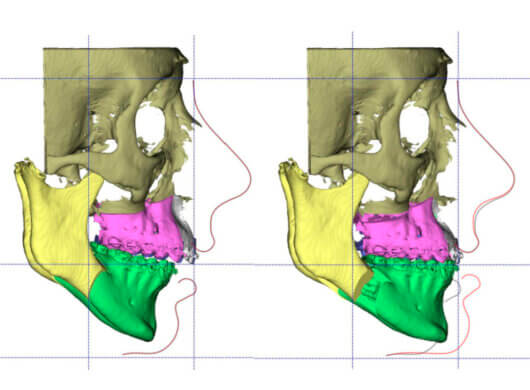Many patients who visit us from other countries want to get their planning done early in their journey, and are surprised to learn that this is not possible until shortly before surgery. Why is this?
Almost half of the patients at the Maxillofacial Institute are international patients from all over the globe, and many of them consult with several surgeons before deciding on one. As part of their decision-making, these patients seek to have a precise treatment plan, with exact measurements and angles, in order to have a point of comparison.
This is perfectly understandable, but in our center, in most cases it is not possible until shortly before the scheduled date for surgery. And this is why:
 On the one hand, to carry out 3D planning of our orthognathic surgery cases, different steps are followed:
On the one hand, to carry out 3D planning of our orthognathic surgery cases, different steps are followed:
- A cranial scan is taken with the bite in centric occlusion
- An intraoral scan of both dental arches
- An intraoral and facial photography session
- Conventional plaster models
With all this information, we create a three-dimensional model of the patient, and on it, the surgeon makes the necessary movements to put the bite in its new position, and create the surgical splints that will be used during surgery. Normally two splints are printed: the intermediate splint, thicker, and used as a first step to mobilize the jaw, and the final splint, much thinner, and used once the jaw has been mobilized, to fit the maxilla in its new position. Both splints must fit perfectly to guarantee correct positioning of the maxillo-mandibular complex.
On the other hand, in the vast majority of cases of orthognathic surgery, it is necessary to carry out preparatory orthodontic treatment. This means that the patient's bite will constantly change throughout this time, until the moment when the orthodontist considers that the patient is ready for surgery. Precise planning can only be done from the moment the pre-surgical orthodontic preparation is completed, and the final three-dimensional patient model is created.
Planning can only be done once the orthodontic preparation is complete, when we are completely sure that there will be no further tooth movement of any kind and that the splints will fit perfectly during surgery.
When is it possible?
However, there are cases in which it is possible to plan almost from the moment of first contact. These are Surgery First cases, where there isn't any type of orthodontic treatment before surgery and where the patient's bite is completely stable.
For all of the above, in the early stages of treatment we can only inform patients of the movements proposed by the surgeon for their case, but it is not possible to make exact planning until the patients come in person to our center for clinical imaging, which is (in most cases) a few days before their surgery.
Related content:
How is orthognathic surgery planned?
What is the role of orthodontics in an orthognathic surgery treatment?








